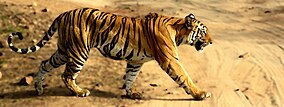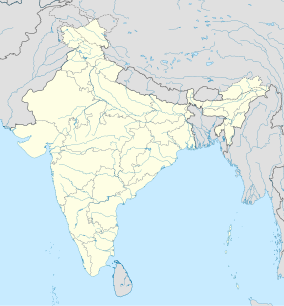Bandhavgarh National Park
| Bandhavgarh National Park | |
|---|---|
 A tigress that is a descendant of tigress Sita and male Charger in Bandhavgarh | |
| Location | Madhya Pradesh, India |
| Nearest city | Umaria |
| Coordinates | 23°41′58″N 80°57′43″E / 23.69944°N 80.96194°E |
| Area | 1,536 km2 (593 sq mi) |
| Established | 1968 Tiger Reserve in 1993 |
| Visitors | 176,051 (in 2022)[1] |
| Governing body | Madhya Pradesh Forest Department |
| forest.mponline.gov.in/ | |
Bandhavgarh National Park is an Indian national park, declared in 1968, located in the Umaria District, Madhya Pradesh. The area was a national park for over 20 years before it was then declared an official tiger reserve in 1993. Bandhavgarh, with an area of 105 square kilometres (41 sq mi), is situated within a greater region of over 716 square kilometres (276 sq mi).
This park has a wealth of biodiversity, with numerous plants, animals, and fungi represented. The park has a large breeding population of Indian leopard, in addition to gaur (the world’s largest bovid), several types of deer, ungulates and monkeys, and various species of birds, reptiles, and amphibians. The park's name is derived from its highest hill, which is said to have been a fort given by Lord Rama to his brother, Lakshmana, in order that he may keep-watch over the kingdom of Lanka; bandhav means "brother", while garh means "fort". An actual fort was built by a Gond Dynasty king.
Prior to the land becoming a tiger reserve—and despite being considered a "conservationist" himself—the Maharaja Martand Singh of Rewa shot a white tiger here in 1951, naming it Mohan. The tiger was stuffed (taxidermy) and put on-display in the palace of the Maharajas of Rewa. Historically, and still to an extent today, villagers and their free-ranging livestock have been at-risk of predation by tigers. However, an increase in mining activities around the park is putting a greater strain on the tigers, and all of the land and its inhabitants.
Structure and layout
[edit]The three main zones of the park are Tala, Magdhi and Khitauli. Tala is the richest zone in terms of biodiversity, with a high number of tigers. Altogether, these three ranges comprise the 'core' of the Bandhavgarh Tiger Reserve, constituting a total area of 716 km2.
Fauna
[edit]

With the tiger as the apex predator of the food chain, Bandhavgarh contains at least 37 species of mammals. According to forest officials, there are more than 250 species of birds, about 80 species of butterflies, and roughly 40 species combined of amphibians of reptiles. Many visitors have the park's birdwatching list at about 350 total species, along with photographs. The richness of resources and tranquil habitat of the region's grasslands invites courting pairs of sarus cranes (A. antigone) to dance and breed in the rainy season. The open forests are home to several monkeys, including the northern plains grey langur (Semnopithecus entellus), the black-footed grey langur (Semnopithecus hypoleucos), and the ubiquitous rhesus macaque (Macaca mulatta).[2]
One of the biggest attractions of the park is the Bengal tiger (Panthera t. tigris). Bandhavgarh has a very high density of Bengal tigers within its dry and open forests. The 105 km2 of park area accessible to visitors was reported to have 22 tigers, a density of one tiger for every 4.77 km2 (population estimation from 2001). The population of tigers in the park in 2012 had doubled and was about 44–49. There is a saying about the park that goes, "In any other Park, you are lucky if you see a tiger; at Bandhavgarh, you are unlucky if you don't see at least one." Bandhavgarh has one of the highest density of tigers anywhere in the world, and is home to some well-known large cats: Charger, a tiger named because of his habit of excitedly charging at elephants and tourists (whom he, nonetheless, did not harm), was the first healthy male known to be living in Bandhavgarh since the 1990s. Charger once appeared on the cover of National Geographic and is considered the second most-photographed tiger in the world. There was also a healthy female named Sita. Almost all of the tigers of Bandhavgarh today are descendants of these two. Their daughter, Joita, and sons, Langru and "B2", also maintained local territories, and kept the park’s reputation for frequent sightings alive, often wandering close to tourist vehicles. Mohini, another female, became a prominent tigress following Sita's death. She mated with another male tiger, Mahaman, although she later died of her wounds from a vehicle collision. Charger eventually died in 2000 and was buried at Charger Point, an area where he had been kept protected in his old age. Between 2003 and 2006, many of his descendants met with a series of unfortunate ends; "B1" was electrocuted and "B3" was killed by poachers. Sita was also killed by poachers. After the death of Charger, the fully-grown "B2" survived as the dominant male in the forest between 2004 and 2007. Mating with a female in the Siddhababa region of Bandhavgarh, he became father of three cubs. One of them was a male. He was named Bamera. He was first sighted in 2008 and is now Bandhavgarh's dominant male. In November 2011, B2 died. Postmortem studies suggested that he died a natural death. However, some locals[who?] still claim that he was killed by villagers in the park’s buffer area. "Blue Eyes" (died due to tranquilizer overdose) and Mukunda were the dominant males of Magdhi and Khitauli, respectively. The females, who are seen more frequently, are Rajbehra, Mirchaini, Banbehi, Mahaman, Sukhi Pattiya and Damdama. There are quite a few cubs also, who are either in their juvenile/subadult stage or have entered adulthood and are forming territories of their own.[citation needed]

The reserve is densely-populated with other species; the gaur, or Indian bison (Bos g. gaurus), were extirpated from the region but have made a comeback, while sambar (Rusa unicolor), chital (A. axis) and northern red muntjac (Muntiacus vaginalis) are commonly seen deer species. Other herbivores include the "blue bull", or nilgai (Boselaphus tragocamelus)—the largest antelope in Asia and second-largest antelope on earth—as well as herds of Eurasian wild boar (Sus scrofa), blackbuck (Antilope cervicapra), four-horned antelope (Tetracerus quadricornis) and Indian gazelle (Gazella benetti), also called chinkara.
There have been reports of the endangered Indian wolf (Canis lupus pallipes), striped hyena (H. h. hyaena) and the Asian caracal (C. caracal schmitzi) being sighted, the latter being an exclusive grassland-dweller, where it may jump several metres in the air to catch fleeing birds. In addition to these carnivores, along with the resident tigers and leopards, other mammalian predators in Bandhavgarh include the golden jackal (Canis aureus), sloth bear (Melursus ursinus), dhole (Cuon alpinus), jungle cat (Felis chaus), Indian fox (Vulpes bengalensis), ruddy mongoose (Urva smithii), Indian grey mongoose (Urva edwardsii) and the Asian palm-civet (Paradoxurus hermaphroditus).[3]
Reintroduction of gaur
[edit]Bandhavgarh National Park had a small population of gaur, but, due to disease passed from domestic cattle herds, most of them had previously died. The project of reintroduction of gaurs dealt with shifting some gaurs from Kanha National Park to Bandhavgarh. 50 animals were shifted by the winter of 2012. This project was executed by Madhya Pradesh Forest department, Wildlife Institute of India and Taj Safaris by technical collaboration.[4]
Transportation
[edit]Bandavgarh National Park is roughly 4.5hrs (~200kms) drive from the nearest major city, Jabalpur. Jabalpur is very well connected to Delhi, Mumbai, Bangalore, Hyderabad, Pune and Indore via air travel. Bandhavgarh does not have the airport facility for mainstream flights, but Jabalpur city, which is the nearest city to Bandhavgarh, has good air connectivity with major cities of India. Private charters can land near Bandhavgarh National Park, Umaria district also has a small air-strip facility for charter planes. Jabalpur Airport (199 km/04:30hrs) is the best option to reach Bandhavgarh National Park as it is connected to: Delhi, Mumbai, Bangalore, Kolkata, Hyderabad, and Bhopal, with these airline options AirIndia, SpiceJet & IndiGo.
Train
[edit]Travel by train is another good option. Travel to Umaria station by train and hire a cab or taxi to the National Park.
Birds
[edit]Some of the typical and peculiar birds found in Bandhavgarh national park are
- Plum-headed parakeet
- Green-headed barbet
- Orange-headed thrush
- Brown-headed barbet
- Coppersmith barbet
- Common myna
- Alexandrine parakeet
- Indian grey hornbill
- Rock pigeon
- House crow
- Carrion crow
- Little egret
- Cattle egret
- Great egret
- Black drongo
- Pond heron
- Common snipe
- Black-winged stilt
- Red-wattled lapwing
- Indian peafowl
- Greater coucal
- Oriental magpie robin
- Indian roller
- Indian robin
- Eurasian collared dove
- Hoopoe
- Sirkeer malkoha
- Large-billed crow
- White-browed fantail flycatcher
- Yellow-crowned woodpecker
- Rufous treepie (normal and pallida)
- Lesser adjutant stork
- Oriental white eye
- Olive-backed pipit
- Spotted dove
- White-throated kingfisher
- Red-rumped swallow
- Lesser whistling teal
- Common kingfisher
- Black stork
- Asian green bee-eater
- Greater racket-tailed drongo
- Red-vented bulbul
- Long-billed vulture
- Grey-capped pygmy woodpecker
- Chestnut-shouldered petronia
- Crested serpent eagle
- Black redstart
- Brahminy starling
- Brown fish owl
- Yellow-footed green pigeon
- Malabar pied hornbill
- Common kestrel
- White-throated fantail flycatcher
- Rufous woodpecker
- Sapphire flycatcher
- Crested hawk eagle (Cirrhatus)
- Oriental turtle dove
- White-rumped vulture
- Lesser kestrel
- Large cuckooshrike
- Pied bushchat
- Black-winged cuckooshrike
- Black-rumped flameback woodpecker
- House sparrow
- Golden oriole
- Rose-ringed parakeet
- Paddyfield pipit
- Dusky crag martin
- Long-tailed shrike
- Black ibis
- White-necked stork
- Purple sunbird
- Giant leafbird
- Tickell's flowerpecker
- Little cormorant
- Little brown dove
- White-tailed swallow
- Jungle babbler
- Shikra
- Jungle myna
- Common tailorbird
- Red collared dove
- Red-necked vulture
- Painted francolin
- Eurasian thick-knee
- Common sandpiper
- Lesser spotted eagle
- Greater whistling teal
- Great cormorant
- Pied kingfisher
- Laughing dove
- Bonelli's eagle
- Dark black crow
- Asian pied starling
- Asian Duck
See also
[edit]References
[edit]- ^ "15L tourists visited MP's 11 national parks till July". The Times of India. 16 September 2022. Archived from the original on 30 September 2022. Retrieved 7 April 2023.
- ^ Umaria, primates (10 September 2024). "Observations • iNaturalist".
{{cite web}}: CS1 maint: url-status (link) - ^ Umaria, carnivorans (10 September 2024). "Observations • iNaturalist".
{{cite web}}: CS1 maint: url-status (link) - ^ "Reintroduction of Gaur (Indian Bison) in Bandhavgarh National Park". Archived from the original on 2013-03-03. Retrieved 2012-04-16.
- Aqeel Farooqi: A Tribute to Charger [1]
- L.K.Chaudhari & Safi Akhtar Khan: Bandhavgarh-Fort of the Tiger, Wild Atlas Books, Bhopal, 2003
- Shahbaz Ahmad: Charger: The Long Living Tiger, Print World, Allahabad, 2001 ISBN 8177380003
- W.A.Rodgers, H.S.Panwar and V.B.Mathur: Wildlife Protected Area Network in India: A review, Wildlife Institute of India, Dehradun, 2000
- Captain J.Forsyth: The Highlands of Central India, Natraj Publishers, Dehradun, 1994. [2]
External links
[edit]![]() Bandhavgarh travel guide from Wikivoyage
Bandhavgarh travel guide from Wikivoyage
- In tiger territory, A.J.T.Johnsingh and Dhananjai Mohan
- Bandhavgarh- Project Tiger
- Forest resource use by people in Protected Areas and its implications for biodiversity conservation: The case of Bandhavgarh National Park in India[permanent dead link]
- Wildlife Times: The Central Indian Tiger Pilgrimage - A trip report
- Map and details of Bandhavgarh Tiger Reserve in Project Tiger website


